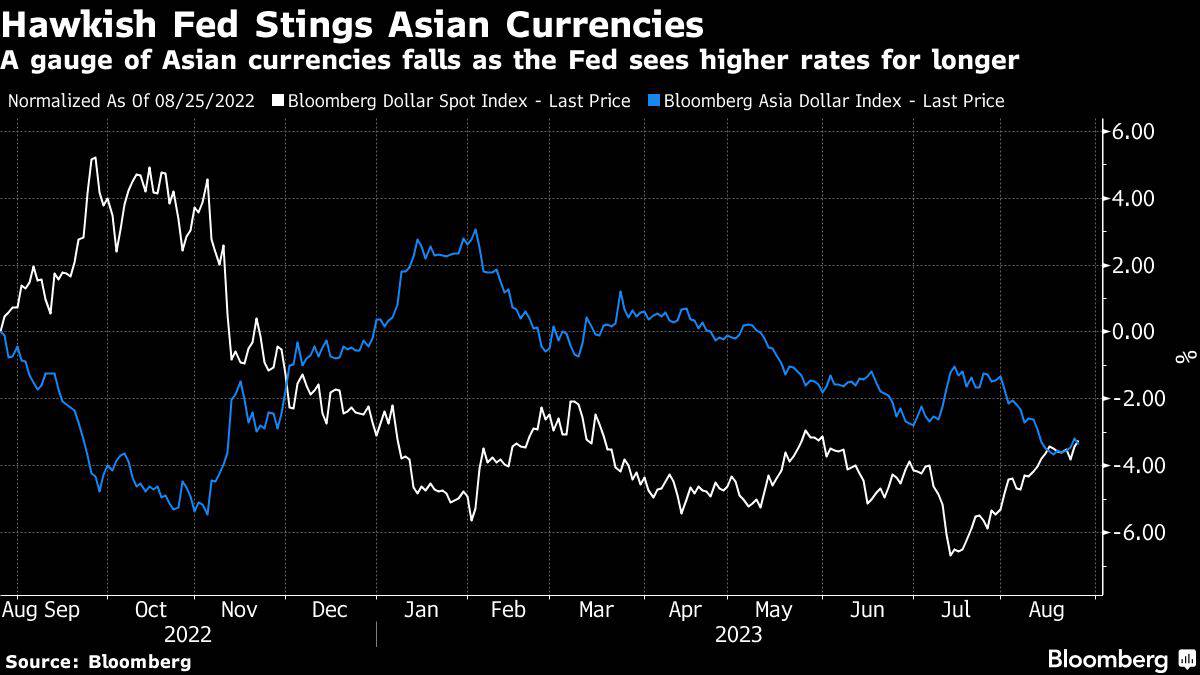As trading began in Sydney, the Australian dollar and the yen showed little movement, but the yen and the yen remained close to their lowest levels of the year. Australian bonds started out slowly as investors took in China’s most recent initiatives to bolster its stock market.
The yield on short-dated Treasuries increased on Friday as Federal Reserve Chair Jerome Powell suggested that the US could raise interest rates once more. In a speech given at the Kansas City Fed’s annual conference in Jackson Hole, Wyoming, Powell stated that the Fed is “prepared to raise rates further if appropriate,” but he also emphasised that monetary policy will continue to be influenced by economic data.
In the meantime, Christine Lagarde, president of the European Central Bank, committed to raise borrowing prices as high as necessary and maintain them there until inflation returns to its target level.
Following Powell’s speech, the real yield on Treasury securities rose to its highest level since 2008, while the yields on policy-sensitive two-year paper increased to 5.09%. Questions over whether Japan could intervene to boost the currency have been raised once again as the yen broke through year-to-date lows to trade close to 147 to the dollar. Equities ended the day up.
Powell’s speech, according to Citi economists Andrew Hollenhorst and Veronica Clark, “goes a long way towards affirming the shift higher in Treasury yields over the last two months.” Powell “clearly and deliberately restated the macroeconomic case for a hawkish bias in Fed policymaking.”
Powell indicates the Fed will maintain its high interest rates if necessary.
In stark contrast to the People’s Bank of China and the Bank of Japan, the Fed is the subject of such debate.
Chinese authorities have persistently interfered to support the yuan, and Japanese authorities have made it clear they are closely monitoring the yen’s fluctuations.
Governor of the Bank of Japan Kazuo Ueda did not address foreign exchange rates during his speech on Saturday in Jackson Hole, Wyoming, but said that price rise is still below the target set by the institution, which explains why policymakers are sticking with their current monetary policy.
A Bloomberg indicator shows that Asian currencies have fallen 2% against the dollar so far this month. As the outlook for the second-largest economy in the world remains bleak, the yuan has lost 2% of its value and just hit its lowest level in nine months.
Despite data released on Sunday indicating that China’s industrial profits declined less in July, the sector is still under threat from the economy’s sluggish recovery and the possibility of deflation. In addition, China pledged to decrease the pace of IPOs and announced steps to help the stock market, including a reduction in the stamp tax on stock sales for the first time since 2008.
Ed Al-Hussainy, global rates strategist at Columbia Threadneedle Investments in New York, predicted a greater intervention in the renminbi and possible verbal intervention in the yen. None of those issues is new; both the yen and the renminbi will be under a lot of pressure. Both of those things have been occurring this year.
What the Strategists at Bloomberg Say…
Numerous factors, such as negative carry against the dollar, a peaking trade surplus, and a normalisation of tourism outflows, might put pressure on the yuan against the dollar. Until the Fed shifts to a more dovish stance and China’s macroeconomic data improves, China could increase currency assistance, but this may only at best moderate the yuan’s decline and not reverse the trend.
— Stephen Chiu, Chief Asia FX and Rates Strategist for BI, and Chunyu Zhang, a contributing analyst
To view the complete column, go here.
The MSCI Asia Pacific Index is already on track to record the largest monthly loss in nearly a year, so the Fed’s hawkish stance may make Asian equities much more painful.
According to statistics collated by Bloomberg, international funds have removed almost $5.9 billion from stocks in emerging Asia, excluding China, so far in August.
In Asia, “high-tech shares will be vulnerable should the US bond yield rise towards 4.5%,” according to Toshiya Matsunami, strategist at Nissay Asset Management in Tokyo. At this time, the yield on benchmark 10-year Treasuries is 4.25%. Companies that manufacture processors for PCs and smartphones will face challenges.

